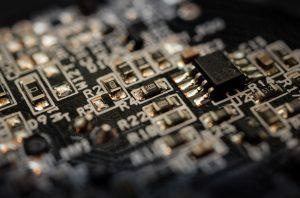Many contemporary electrical systems are reliant on transistors. These are the building blocks of many systems, thanks to their ability to perform exceptionally fast current switching and efficient signal amplification.
Transistors can be engineered in minuscule formats, down to the nanometer (nm) range. Their distinct combination of size and efficiency sees them at the forefront of a new era of microelectronics, replacing traditional bulky vacuum tubes.
Transistors’ exponential miniaturization has led to a key emphasis being placed on material purity, with certain semiconducting devices necessitating impurity limits as strict as one part per billion (ppb).
The use of high purity platinum foil is common in microelectronics fabrication due to its inertness, ductility and favorable conductivity.
Prior to the advent of integrated circuits (ICs), platinum was generally reserved for use in electrical contacts, largely due to its negligible reactivity. This also led to the development of non-oxidizing, long-lasting elements that were not impacted by high operating temperatures.
These essential properties have led to platinum foil becoming a key material in the development and manufacture of high technology electronic devices.

Image Credit: XRF Scientific
Case Study: Auxiliary Electrodes for Supercapacitors
Voltametric analysis facilitates the exploration of the half-cell reactivity of a particular analyte. This is typically performed using a triple electrode cell that is made up of working, auxiliary and reference electrodes.
The auxiliary (or counter) electrode in these cells has long been made from platinum wire due to its capacity to allow for a stable current flow without affecting the chemistry of the solution being investigated.
A larger auxiliary electrode that is capable of supporting high currents is required when carrying out bulk electrolytic analysis. This has seen platinum foil increasingly utilized as the auxiliary electrode because platinum foil offers a larger surface area than a basic platinum wire. This has also enabled the charge injection capacitance to be increased.
Platinum foil is highly suited for the enhancement of electrical capacity in a wide range of microelectronic devices. It is a key material used in on-chip capacitors as ohmic contacts, as well as seeing regular use as an intermediary in multilayer ceramic capacitors.
Platinum foil is also highly desirable for supercapacitor research and development (R&D).
Electrochemical supercapacitors operate on the principles of voltammetry previously discussed, but these also exhibit ultra-high capacitance with lower voltage limits. These characteristics are a result of the migration of ions between two isolated nonreactive electrodes present in electrolytic suspension.
This approach offers a number of advantages over current energy storage devices, even though these will discharge power relatively quickly. Advantages include rapid charging and higher stability when used within power supplies.
Platinum Foil from XRF Scientific
XRF Scientific supplies a wide range of precision platinum products designed for basic electronics and high technology applications.

This information has been sourced, reviewed and adapted from materials provided by XRF Scientific.
For more information on this source, please visit XRF Scientific.